Related Research Articles
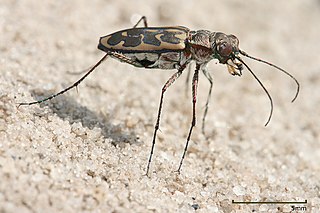
Tiger beetles are a family of beetles, Cicindelidae, known for their aggressive predatory habits and running speed. The fastest known species of tiger beetle, Rivacindela hudsoni, can run at a speed of 9 km/h, or about 125 body lengths per second. As of 2005, about 2,600 species and subspecies were known, with the richest diversity in the Oriental (Indo-Malayan) region, followed by the Neotropics. While historically treated as a subfamily of ground beetles (Carabidae) under the name Cicindelinae, several studies since 2020 indicated that they should be treated as a family, the Cicindelidae, which are a sister group to Carabidae within the Adephaga.

Neocollyris is a genus of tiger beetles in the family Cicindelidae, in the tribe Collyridini.
Pronyssa is a genus in the beetle family Cicindelidae. There are about eight described species in Pronyssa.

Therates is a genus of tiger beetles found in South and Southeast Asia. A study of two species in the Philippines suggests that females tend to be larger with wider elytra width.
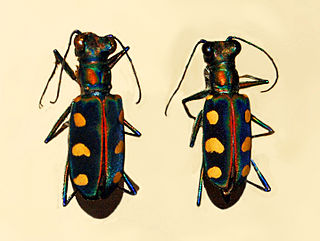
Cicindela aurulenta, common name blue-spotted or golden-spotted tiger beetle, is a beetle of the family Cicindelidae.
Neocollyris pacholatkoi is a species in the tiger beetle family Cicindelidae. It was described by Sawada and Wiesner in 2006 and is endemic to India.
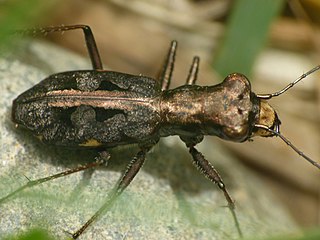
Cylindera dromicoides is a species of tiger beetle of the family Cicindelidae. It is flightless and has been found mainly along the Himalayas from India through Nepal and Bhutan and in the Chinese province of Yunnan.

Cicindelini is a tribe of tiger beetles in the family Cicindelidae, containing the overwhelming majority of genera and species in the family. There are more than 90 genera and 2,000 described species in Cicindelini.

Cosmodela duponti is a species of tiger beetle with wide distribution range in Southeast Asia. They are found mainly in forested habitats. Two taxa formerly treated as subspecies under this species, Cosmodela barmanica and Cosmodela indica, are now treated as full species.
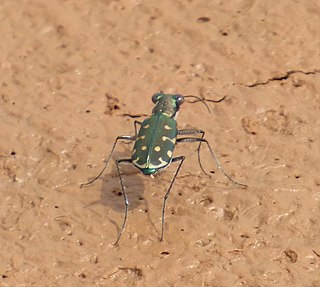
Myriochila distinguenda is a species of tiger beetle found in South Asia. It is found mainly on the muddy shoreline around freshwater. The genus Myriochila is characterized by hooked setae on the femora and four hairs on the pale or whitish labrum.

Cylindera umbropolita is a species of tiger beetle found in India. It was originally described as a subspecies of Cicindela belli.

Calochroa hamiltoniana is a species of tiger beetle endemic to the southern Western Ghats of India. It is found only on the shaded floor of dense and moist forests. They are mostly active on the forest floor and fly to low vegetation when disturbed. It is 14 to 17 mm long and has the pronotum and elytra largely greenish or bronze with an orange stripe bordered by black on the inside running along the length of the elytra.
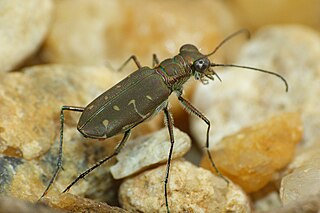
Calomera fowleri is a species of tiger beetle endemic to peninsular India. It is found foraging on wet sand and riverine areas in the edges of forests. It is somewhat similar to Calomera angulata but that species is found on open sandy beaches, has bolder markings and longer mandibles.
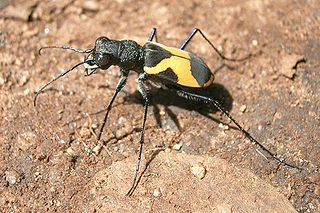
Cicindela goryi is a species of tiger beetle from southern India. It was earlier treated as a subspecies of the closely related Cicindela aurofasciata.
Cicindela andrewesi is a species of tiger beetle. It is Endemic to India.

Cylindera collicia is a species of tiger beetle endemic to southern India. About 8 to 9.5 mm long, it is found in forested habitats in the Western Ghats. It is attracted to lights at night.

Cosmodela barmanica is a species of tiger beetle found in Asia. The species was formerly treated as a subspecies of Cosmodela duponti. The species has a disjunct distribution with one population in the Western Ghats of India and another extending from the northeast of India into Thailand, Myanmar until Malaysia.

Cicindela calligramma is a tiger beetle endemic to peninsular India and Sri Lanka. They are 13 to 16 mm long with a green or coppery brown body and three prominent yellowish markings. The ground colour varies a lot. They are found on the ground inside thin forest. They can be confused with Cicindela guttata which has hairs only on the lower part of the cheeks.
References
- ↑ Pearson, D.L.; Wiesner, J.; Acciavatti, R.E.; Uniyal, V.P.; Anichtchenko, A. A field guide to the tiger beetles of India. Dehra Dun: Bishen Singh Mahendra Pal Singh. ISBN 9788121109338.